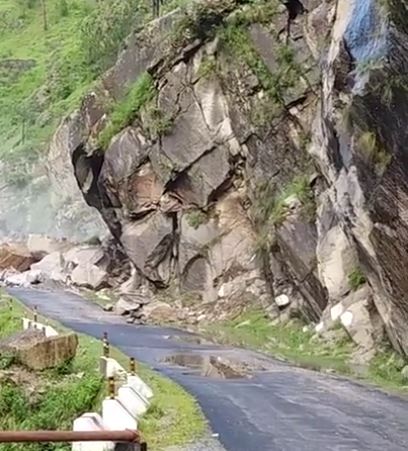11 March 2019
A video of a small but spectacular rockslide from Uttarakhand
Posted by Dave Petley
A video of a small but spectacular rockslide from Uttarakhand
A video has been posted onto Youtube showing a reasonably small but undeniably spectacular rockslide:-
.
In the comments section the location is described as being Uttarakhand, but no further details are provided. [Update – in a tweet SANDRP reports that the location is Bhatwadi in Uttarkashi district, and that the landslide happened last year] This appears to be to be as good an example as one could wish to find of a rockslide caused by discontinuities (joints) aligned with the slope – take a look at this still from the start of the video:-

The rock slope in Uttarakhand prior to the failure. Still from a video posted on Youtube by Sanjay Bisht.
.
The plane of weakness on which sliding occurred can be clearly seen. It appears that in constructing the road the toe of the landslide has been removed, leaving the rock blocks free to slide on that surface. Failure then occurs sequentially, with further failure of blocks at the toe of the slide destabilising the main rock mass. When sliding initiates the blocks move along this surface until free to fall:-

The rock slope in Uttarakhand as the the failure develops. Still from a video posted on Youtube by Sanjay Bisht.
.
Once free, the mass rapidly fragments, although some large blocks remain intact:-

Full failure of the rock slope in Uttarakhand. Still from a video posted on Youtube by Sanjay Bisht.
.
This is a fine example of the need to ensure that rock slopes are properly assessed and, where appropriate, engineered to prevent failure. The need for a proper engineering approach has been described in detail over the last 30 years by Dr Gareth Hearn. He has a good presentation summarising the key issues (NB PDF). The techniques for preventing this type of failure are well established and comparatively simple to implement, but in many mountain areas a combination of a lack of resource and a lack of expertise mean that this does not happen. The upshot is increased disruption, high levels of hazard and, when the slope fails, substantial environmental cost.


 Dave Petley is the Vice-Chancellor of the University of Hull in the United Kingdom. His blog provides commentary and analysis of landslide events occurring worldwide, including the landslides themselves, latest research, and conferences and meetings.
Dave Petley is the Vice-Chancellor of the University of Hull in the United Kingdom. His blog provides commentary and analysis of landslide events occurring worldwide, including the landslides themselves, latest research, and conferences and meetings.
Land slide due the rocks slopes not being properly engineered as the toe portion of road cleared but slopes stability correction not performed and the slope lies on the plane of discontinuities remaining part of the rocks slope being left as free fall condition after the construction of the road section .
The video is instructive The photographs reveal that a correct analysis of the joint patterns was not made. From the photographs it is evident that there are three sets of prominent joints ;-one that dips towards the road with the other two complementary joints dividing the rocks into cubical rock blocks in which the removal of toe support from the joint dipping towards the road was the prime causative factor. Hence while planning road cuts, it is essential that the joint planes are carefully geologically analysed as to the dips ; the material filling the joints; rugosity; openness i.e. spacing which may give access to water.. Such conditions are commonly prevalent in hilly terrains.
The types of slides can happen anywhere, along the roadcuts (dhule or paved), in the mountainsides in Nepal. So, being aware of the slightest indications related to failure will
lead to saving lives and properties. Of course, for engineering geology students in particular,
this slide can be a class-room exercise to test what they learnt thus far and try simple modelling/simulation of rock failures.
Gautamjee, RELEVANT and informative comments. Tqu.